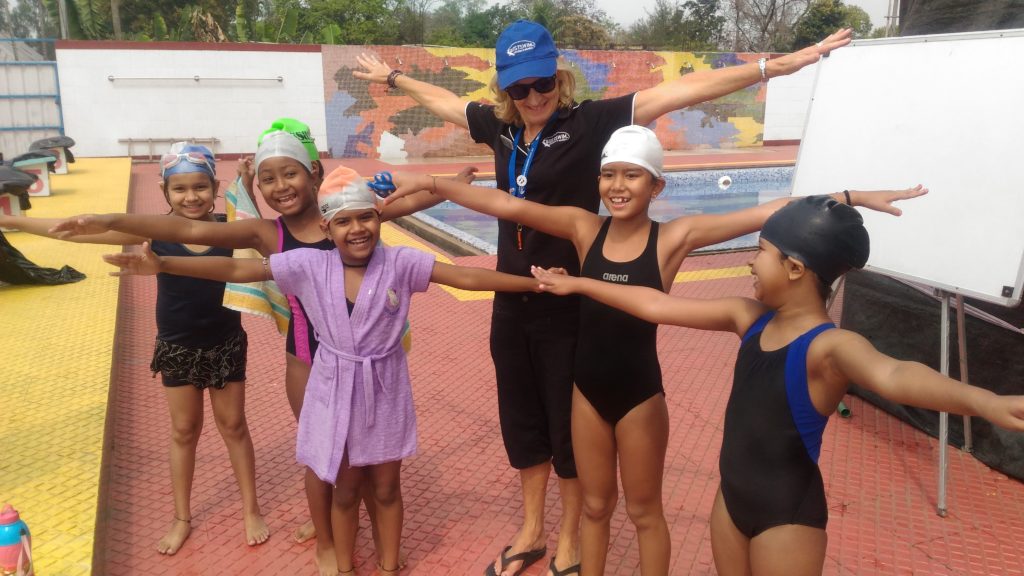
Swimming and Water Safety education is important. So when should learning start, what should you look for, how long will it take and how will you recognise quality programs? It can be confusing; here are a few tips to assist.
What is the best age to start swimming lessons?
Formal lessons can begin as early as 6 months with an appropriately qualified teacher and safe environment. Until then a lot of introductory water familiarisation can also be achieved under the right conditions and with well sourced knowledge – more on that at a later date.
But remember, it’s never too late to learn swimming and water safety.
What should you look for in swimming lessons
TEACHER QUALIFICATIONS
Check on staff qualifications. All teachers should be holding Teacher of Swimming and Water Safety Licence. In addition, the teacher should be appropriately licensed to teach special groups e.g. infant accreditation when teaching children between 6 month and 4 years of age.
An example of a high quality teacher accreditation is AUSTSWIM (the Australasian Council for Teaching Swimming and Water Safety) which accredits and licenses teachers of swimming and water safety (Swimming Matters, a brand of Winning Matters, is working closely with AUSTSWIM to bring its world-class teacher training programs and best practices to India).
AT THE POOL
Visit and talk to staff and parents enrolled in the program. Check for appropriate signages and safety measures at the pool. Ensure a certified lifeguard is on duty during class hours. Water quality, depth and temperature are also big considerations. Children cannot concentrate for long periods if they become cold or cannot stand comfortably when learning and this greatly affects their progress.
QUALITY PROGRAMMING
Quality programs combine variation of movement and body position within the one activity where students experience changes in body position (front, back, side, roll, rotate). There should be no ‘turn waiting’, students should be actively engaged in discussion or activity. The use of flotation aids should be minimal, providing opportunity to practice with and without aids. Remember that no student should be forced beyond their comfort or developmental stage. Class sizes should cater to the needs of the child and smaller group sizes promote a safer learning environment.
Quality programs provide:
- Physical and intellectual challenge
- Stimulation
- Engagement, enjoyment and interaction
- Opportunity to learn through well planned and enjoyable activities
Seek a program that combines swimming stroke development, with personal water safety, survival knowledge and body orientation skills.
These well-rounded programs deliver more than ‘lap swimming lessons’, they provide excellence aquatic education!
Parents Supervision
Aquatic accidents are silent killers. You don’t hear a child drowning or in trouble in the water, there’s no screech of brakes or a cry as a child falls over, they simply slip silently under. In addition to an alert lifeguard, a parents’ eyes and arms in close proximity will help prevent children from drowning.
How long does one take to learn Swimming and Water Safety Skills?
Learning is a continuous personal process unique to each individual and evolves over time. Ongoing consistent participation aids the learning process. Learning is influenced by the child’s health and development, and previous aquatic experiences.
Learning anything new takes time. The cycle generally includes:
- Getting to know the environment
- Understanding what’s required
- Trial, error, practice and improvement
- Skill acquisition
- Educated feedback
It is a completely new experience – a new type of clothing, a new medium like water and a different temperature feel – and this can be challenging initially for first-time learners. We’re basically upright creatures; swimming requires lying on your back or stomach and many students feel insecure in these positions when in water. It takes time to get used to a water environment and relearn land based skills in the water. Vertical comfort and skill must first be mastered before progressing to a horizontal position; the rate of progress is individual.
You can help the learning process by:
- Asking questions to get your children thinking about aquatic environments.
- Encouraging your children to believe in their own abilities.
- Engaging your children in conversation topics including:
- Tell me what you learnt or practiced today
- What was enjoyable/challenging?
- What was the discussion?
- Tell me who you worked with/helped today?
- Assist your child in understanding that mistakes are part of growing & learning
- Encouraging interaction and participation in aquatic activity
- Establishing, modeling and enforcing safe aquatic behaviors
What should Swimming Lessons Include?
– A positive welcoming environment.
– A program that includes the parent / caregiver as part of the learning process
– Curriculum that provides linked activities focusing on:
- Water familiarisation
- Personal water safety
- Aquatic survival knowledge and skill
- Steps towards stroke development
Taught by a licensed teacher.
